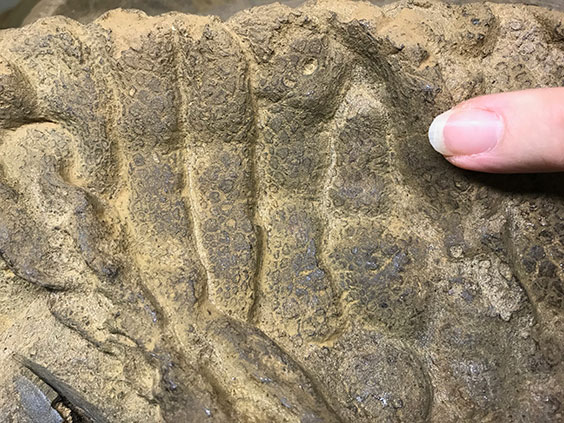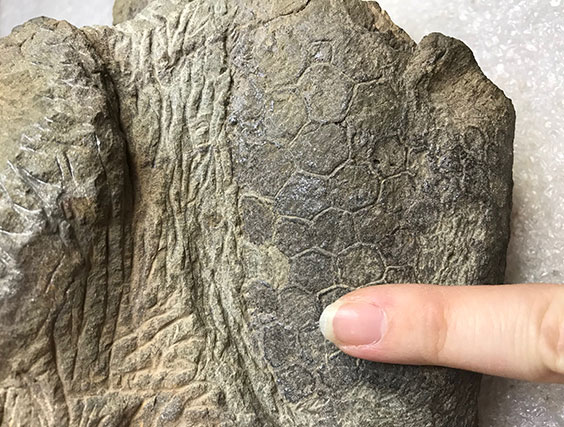Some of you may be noticing that the “Dakota the Dinomummy” exhibit at the State Museum looks a little . . . different. Don’t worry! Nothing is wrong, we are just in the initial phase of producing a new exhibit for everyone to enjoy. Since Dakota is quite the rarity (one of about six hadrosaur mummies in the world), and because it’s large and difficult to understand what the fossil contains, we decided it was time for a makeover.
Over the next number of months, parts of the current display will be removed for continued preparation and study. The first pieces to go are the arm, one foot, the tip of the tail, and the tail itself. What we call the “body block” will remain on exhibit for a while yet. The pieces that have been removed still have matrix (the unprepared rock) attached, which needs to be carefully chiseled off. The dinomummy as it sits now has had five years of preparation completed. Five . . . years . . . of people sitting around the blocks with pneumatic chisels and magnifying lenses, carefully removing the matrix grain by grain. After five years, there’s still a lot of work that can be done!
When a large fossil is removed from the ground, we have to flip it over to cover the bottom-side of the plaster “jacket.” To avoid damage to the fossil, this usually means that the bottom-side of the fossil is opened and prepared first. This works well, because the bottom of the fossil has had less exposure to destructive elements (wind, rain, snow, cows, etc.). So if only one side of the fossil will be prepared, in this case due to the size, weight, and fragile nature of the specimen — then the bottom is the way to go. The tail will be prepared this way.

Skin found near the elbow of the dinomummy, with small scales and wrinkles to accommodate movement.
Other portions, such as the arm, are small and stable enough to prepare in-the-round. As you can see in the photos, the scales are vastly different depending on where you look. Toward the elbow, where the skin would stretch and move, the scales are very small, with wrinkles to accommodate movement — much like your elbows (sans scales, of course). The larger scales are found on the back of the arm and are relatively smooth. This would represent the mid-forearm on people, between the wrist and the elbow — an area with no movement.

Skin found mid-forearm on the dinomummy, with fingernail-sized scales. This is an area between joints, without movement.
If you would like to follow along with the continued preparation of the tail, foot, and arm, we will have periodic updates on Facebook, Twitter, and Instagram (@NDGSPaleo, @ndmuseum). We have to remove as much matrix as soon as possible so we can have the tail 3D scanned. Our goal is to have a 3D-printed, touchable tail for visitors to interact with. The real thing will still be behind glass, but this way the public can truly pet a dinosaur.

